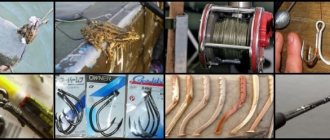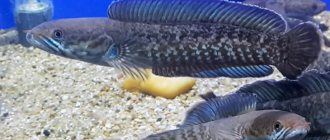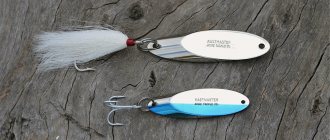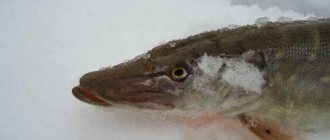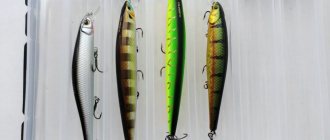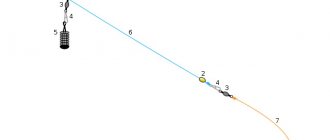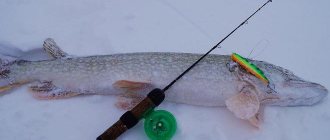Lures used
Natural, that is, live frogs are used as bait for catching predatory fish species, including:
- pike;
- catfish;
- asp;
- zander;
- burbot;
- perch;
- chub.
These baits have the following advantages of their use:
- Live frogs live in the same environment as predatory fish, so they often become their food in the natural environment, which increases the chance of the fish biting on bait that is already familiar to it.
- Frogs have a fleshy body that holds well on a hook, unlike bloodworms or maggots.
- Frogs are an excellent bait for attracting large species of fish, in particular catfish and pike perch, which will never refuse such a delicacy.
- A bait consisting of a frog can significantly revive a weak fish bite.
The disadvantages of using live frogs as bait include the following:
- The frog must be killed before being hooked, which is sometimes difficult for compassionate fishermen.
- Catching a frog in the natural environment can be quite difficult for anglers who have never done it before.
- Live frogs cannot be stored for long, so this bait is considered disposable.
In order to catch a live frog, you should follow these tips:
- During the summer season, the easiest time to catch a frog is early in the morning or after sunset. During the daytime, all types of frogs usually hide in thick grass or water.
- In cold weather, frogs move to shallow water, where they lie down under stones or sheltered holes.
- To use frogs as bait, you should take small young frogs with a green color, since fish like them most.
- Frogs should be caught using a net. They should be placed in a damp cloth bag, into which the herbs must be applied in advance.
- If you can’t catch a frog with a net, you can use a regular fishing rod. To do this, attach a piece of grass or a fly to the hook. The frog will attack such bait and be caught like a fish.
- There are cases when fishermen bred frogs on their own in their own garden. To do this, you just need to collect its eggs and place them in a container of water. After two months you will be able to hatch live bait.
In addition to live frogs, you can also use artificial imitators of these animals.
They can also catch predatory fish (ide, pike, perch), but not all of them, since the rubber bait does not have the desired smell.
The advantages of using artificial frogs include the following:
- Artificial baits in the form of frogs are more convenient when used in hard-to-reach areas where snags are possible, since they simply crush them, unlike live frogs.
- A huge variety of these baits can satisfy even the most original needs of anglers.
- Artificial frogs can be used many times.
However, such baits have a number of disadvantages:
- Artificial frogs lack the natural smell of meat, which does nothing to attract fish. Of course, you can add various flavors to them, but you still can’t replace the true smell of a frog.
- These baits have a bright color, but an overly vigilant and suspicious fish may still not risk biting on such a bait.
The subtleties of catching a live frog
To attract and provoke a pike to attack, you must not only have a live frog available, but also the right tackle.
Where to look for bait
It is best to go hunting for a frog in the evening or morning hours, before the grass dries out. Looking for it at lunchtime, when it’s hot, is not effective; it hides from the sun in dense thickets. Due to the coolness, searches should be carried out in shallow water, under stones, logs near the coastal zone.
The predator responds well to small and medium-sized frogs of green color, especially young individuals. For ease of catching, either a net or a fabric bag is used. As an option, a regular fishing rod with any blade of grass on the hook will do. As soon as such a bait enters the frog’s field of vision, it immediately captures it. Another method of extraction is the use of flies, which are kept in linen bags with grass.
Photo 2. Princess frog.
If you have the desire and opportunity, then you can raise frogs in the garden with your own hands. First, frog eggs are collected, placed in a suitable container with water, and placed in a sunny place. And after a couple of months, the bait for the predator will be ready.
Gear selection
Among the catchable gear for predators, the following are distinguished:
- girders;
- snacks;
- spinning.
To catch pike with a live frog you will need:
- spinning rod 2-2.4 m long with casting parameters up to 30 g;
- high-quality reel model with a metal spool up to 2000 in size;
- braided cord with a thickness of up to 0.12 mm/monofilament scaffolding with a cross-section of 0.28 mm;
- reliable carabiners and clasps.
It is not necessary, but it is advisable to use a leash.
Tips for hooking a live frog:
- A single hook is passed through the hind leg. This allows the bait to move freely. But this method has its drawback - the risk of losing the bait during its delivery to the fishing point.
- The use of three single hooks located on a separate leash. They need to be placed in the back of the bait with the tip pointing out.
If a dead specimen is used, the hook should be passed through the mouth with the sting exiting through the back behind the front legs. Alternatively, you can hook one paw onto the sting to make the bait more attractive; its play will be more interesting for the predator. This technique does not affect the quality of the hook at all, but it only affects the effectiveness of the tackle in the best possible way; it increases it.
Tactics and technique
Having decided on the fishing location, it is necessary to cast a live frog hooked on the leg. You need to aim at the windows between the underwater vegetation. After which, a pull is made, wriggling in the water, the bait attracts attention and provokes the pike to attack. There is no point in relaxing here; as soon as the predator grabs the bait, you should make a confident hook.
If the hunt is for a killed individual, then the speed of rotation of the reel should be average with periodic stops for jerky movement of the frog. For greater efficiency, it is worth twitching the rod tip.
Using either a dead or a living frog on pike in thickets or open spaces is equally effective. There are situations when the use of spoons and wobblers does not give the desired effect, then amphibians are used. They work so well that even passive fish are interested.
Tackle for frog fishing
The most suitable tackle for frog fishing is bottom tackle. It includes the following elements:
- A powerful bottom rod with a rigid tip and a length from three and a half to seven meters.
- A capacious reel made of high-quality material, preferably with a friction brake system.
- A weight with a flat shape and a weight of at least two hundred grams.
- The leash is made of durable monofilament fishing line with a length of forty centimeters.
- A hook with a sharp sting and a thick long shank. The hook number should be from eight to fifteen.
Catfish fishing technique
The frog is very good for catching catfish, but is absolutely not suitable for catching other predatory fish. This is due to the fact that after 40 minutes of being under water, it dies from lack of oxygen. No other fish, except catfish, will want to swallow such bait after this. Therefore, classic frog fishing involves constantly pulling the frog out of the water so that it replenishes its air supply. That is, every 20-25 minutes , you will have to check the bottom tackle to see if the frog is alive. This is not very convenient, and no one is going to do this kind of fishing.
As a rule, catfish are caught using a girder if a frog is used for this. It’s not difficult to make such tackle yourself or buy it at a fishing store. It consists of an ordinary stick to which a thick fishing line or fishing line is attached, with a corresponding hook at the end.
The fishing line is fixed on the shore, and a frog is attached to the hook and cast away from the shore. As a rule, the catfish’s favorite places are pits, where it feeds. At the same time, he is able to leave them, especially at night, when his search for food intensifies. The fishing line or cord must be strong enough to support a large catfish, and even one that can bite, and the tackle must be securely fastened to the shore. Sometimes fishermen tie the tackle to a tree, which guarantees the retention of a large specimen.
kwok method of catching catfish is very popular . This is a special device that allows you to make sounds (quacks) that attract catfish. Moreover, you can catch catfish with the “kwok” both at night and during the day.
With this method of fishing, you must have a boat, since it will not be possible to fish from the shore with a “kwok”.
The technique for catching a hook is as follows: first you need to put a frog on a hook. It is placed on the hook by the hind leg, but under no circumstances in any other place and lowered into the water. After this, using a special device, you should start “knocking”. Every 20-25 minutes, the frog is pulled out of the water and allowed to catch its breath for 10 minutes, after which it can be lowered into the water again. One frog can last for half a day. For this purpose, medium-sized frogs are selected, which are most attractive to catfish.
This type of fishing is quite interesting, since the frog is a favorite bait for catfish . Having seen its prey, the catfish can easily swim into shallow water. This type of fishing is simple and very accessible due to the huge amount of bait floating around us in the reservoirs.
How to impale a frog
There are three main ways to hook a frog. Let's look at each of them:
- In order to achieve a good “game” of a live frog, it must be correctly placed on the hook. To do this, you need to insert the stings of the double hook through the frog's mouth and out under its front paws. After this, one of the frog's paws is thrown over the hook's sting. Then you need to prick the frog muscle from the forearm onto this sting. The hook tips should be visible.
- This method of cage does not require killing the frog. And although this is a rather cruel method of baiting, it is also practiced by many fishermen. The nozzle is performed in this way:
- Hook the hook onto the back skin of the frog so that the hook tip comes out.
- This must be done in such a way that the frog cannot free itself.
- The last method of attaching a frog is done this way:
- Using a double hook, insert the dead frog through its mouth and bring the hook point out through the animal's belly.
- Then pry the frog's muscles with the stings again.
Such a bait will have a good “game” and spin on the hook.
How to bait a frog
When fishing with a live frog, you need to put it on the hook so that it can realistically move through the water column. Most often, anglers place this bait behind their back or hind leg. When hooking this amphibian onto its back, care must be taken not to damage its spine. This will lead to the fact that the amphibian will move little and quickly die.
If you want to know how to hook a frog, the easiest way to do this is to pierce its back leg. This method does not require special skills and is suitable for beginners. If a dead amphibian is used as bait, the hook can be passed through the lip.
In order for the frog to remain alive for a long time, move around and attract the attention of fish, it must be periodically given a sip of oxygen. To do this, you need to re-throw the tackle more often. If there are several amphibians at hand, then they need to be changed periodically, since they quickly get tired and stop moving.
Some anglers believe that you need to fish with a dead frog. In this case, they use 2 or 3 hooks at once. Hooks can be used to pierce the back, one and the other lip, the front and back paws. In this case, you can use both doubles and simple single hooks.
Frog fishing technique
The fishing technique for artificial and live frogs can be very different. Its basic principle includes the following actions:
- Place the frog on the hook and cast (preferably into coastal weeds or places where other frogs live, since this is where predatory fish often swim in search of food).
- Wait until the bait sinks to a sufficient depth.
- Retrieving the frog can be done in jerks with short stops or in regular stepwise retrieving. When retrieving the bait, the fisherman must constantly twitch the tip of the fishing rod so that the frog “jumps” more naturally in the water. Also, you should strive for maximum naturalness, but this usually comes with experience.
- When biting a frog, you should not flinch in surprise, since, as a rule, the fish grabs it sharply and pulls it deep to the bottom with a loud pop.
- You should wait until the fish is likely to catch the hook, and only then hook.
Fishing with a spinning rod on a frog without hooking
Fishing for pike with a non-hooking frog can be carried out throughout the entire summer and autumn season in reservoirs with a high level of overgrowth. Fishing is carried out in water areas with shallow depths, rarely exceeding a 2-meter level. Pike in such places are accustomed to picking up baits from the surface and readily respond to the bait they like and cause irritation.
Important! The trajectory of the unhooked hook is chosen taking into account the maximum possible capture of windows among the algae, making pauses and small jerks in such places.
Areas near reed walls also look like promising places for wiring. The trajectory of the bait should be a meter and a half from the wall of the thicket and will be carried out according to the twitching principle. The predator’s approach to the bait is noticeable by the sharp movement of surface plants, which subsequently results in a bright attack from the fish in the form of a surface capture of the bait. The fisherman visually observes the selection of unhooked fish, which adds attractiveness and special surroundings to the fishing method. When fishing, the cord is constantly kept in tension, not allowing the fish to make candles and go into underwater plants for shelter.
Read how to hook and land pike on a spinning rod for a beginner.
Features of fishing depending on the type of fish
Catching pike with a frog has the following features:
- You can catch pike using either a live frog or an artificial frog. The main thing is that it has a good game in the water, since the pike pays most attention to this indicator, and not to the color or smell of the bait.
- The introduction of the frog to the pike should be slow and as natural as possible. Even the slightest discrepancy in the game or behavior of the frog can make the fish doubt and refuse to bite.
- You need to fish out the pike after you are sure that it has swallowed the hook, otherwise it can easily spit out the bait and swim away.
Catching catfish with a frog has the following features:
- Frog bait is very popular for catching catfish as it is a common food source for this fish in the wild.
- It is better to catch catfish with a live frog, since it is very sensitive to odors and will probably not be interested in rubber bait.
- The best time to catch catfish with this bait is on warm summer evenings when there is no wind. On such days, the catfish feels calm and swims out of its rookeries to feed.
- The best gear for catching catfish with a frog is a zherlitsa, donka and kwok. In addition, you should know that catfish is a fish that can weigh up to three hundred kilograms, so to catch it you should use the strongest possible gear and equipment, including fishing line, hooks and leashes.
- To catch catfish, you should use large frogs weighing about one hundred grams so that they can attract the attention of large catfish.
- The most favorite places for catfish to be in the water are deep holes and snags, so the bait should be cast not far from these places.
- When catching a large catfish, it is very difficult to fish it out and drag it onto the boat, since it has enormous strength and does not give up without resistance. In such cases, experts recommend hitting the catfish on the head with an oar.
Catching a snakehead with a frog has the following features:
- Snakeheads are very active in biting both live and artificial frogs. The best time to catch it using these baits is summer.
- When choosing artificial bait for snakeheads, you should pay close attention to the quality and softness of the rubber. It must be soft enough so that the fish does not smell the substitution, otherwise there will be no bite.
- It is advisable to add lead to the bait so that it can sink to greater depths, where the snakehead lives.
- This fish always bites the bait quite effectively, making bright squelches of water. These show bites should not force the angler to hook prematurely, since the fish is only playing with its prey. In order to successfully hook a snakehead, and not lose it, you should wait twenty seconds after the fish is hooked on the hook's sting.
Catching burbot with a frog has the following features:
- Burbot is a cold-loving fish, so you need to catch it with a frog in the fall or winter.
- For winter fishing, you can use various artificial frogs with a slight depth and good game.
- Burbot responds well to baits of green and light green colors.
- Since this is a fairly strong fish, you should stock up on several leashes and hooks at once.
Catching perch with a frog has the following features:
- It is advisable to catch perch using small live frogs. It is also possible to use artificial baits, which should contain a small red pigment that perch like so much.
- Perch often lives in quiet areas of water bodies, so you need to throw the bait there.
- To catch perch, you can make combined baits consisting of a small frog and artificial bait.
- Perch is best caught with this bait in the fall.
Catching chub with a frog has the following features:
- To catch chub, you can hook several frogs at once. It is important that they are alive and moving. Thus, the bait will be much more effective.
- It is best to catch chub with a frog from a boat, since this way you can get to hard-to-reach areas of the reservoir where this fish often lives (snags, flooded trees, underwater holes).
- When catching chub from the shore, the tackle must be thrown three meters from land into a clean area of the reservoir, where there are no snags or stones, otherwise live frogs will be able to get off the hook and escape.
- A very effective way of catching chub is to cast with frogs all night long using the so-called “sucker”.
When and where to catch a frog
As soon as the reservoir warms up to a temperature above 8–10 degrees, amphibians begin to actively emerge from hibernation and immediately become included in the list of victims of the toothy predator. Consequently, you can catch a pike with a frog from mid-spring to late autumn, when tree frogs, huddled in dense groups, fall into prolonged suspended animation. Fishing with this type of bait is carried out in the immediate habitats of amphibians. They live and feed in stagnant or weakly flowing reservoirs, staying in shallow areas with a high degree of overgrowth.
As a rule, these are coastal zones with depths of up to two meters near the walls of reed or cattail vegetation, as well as shallows with lotus, egg capsule or water lily, forming in their colonies clean, small spaces of water in the form of windows and gaps. Based on these factors, the fisherman should select promising places for fishing, placing rigs on the borders of algae and clean water areas, as well as in the gaps between floating plants.
Blitz tips
- Fishing with a frog usually takes place in heavily snagged and hard-to-reach places where large fish live and serious snags on the gear are possible, so the fisherman should tie several leashes in advance and prepare spare hooks.
- When choosing an artificial frog, preference should be given to those baits that most accurately copy a living frog.
- Artificial baits should be stored separately from each other so that they do not deteriorate due to the joint reaction of the materials.
What is an artificial frog?
This bait, popular among fishermen, can be purchased at any specialty store.
Their range is so diverse that it is difficult for a beginner to choose the right one. Therefore, get to know the different types of artificial frogs.
Artificial frogs can be made:
- made of rubber;
- made of plastic;
- made of silicone;
- made of plastic;
At the same time, plastic frogs are much more expensive than rubber ones. Experienced fishermen use homemade frog baits made from various materials, including pieces of fur or wool.
Don’t forget that artificial baits should be stored separately from each other, including frog baits. After all, these are just artificial products that can deteriorate due to random chemical reactions.
